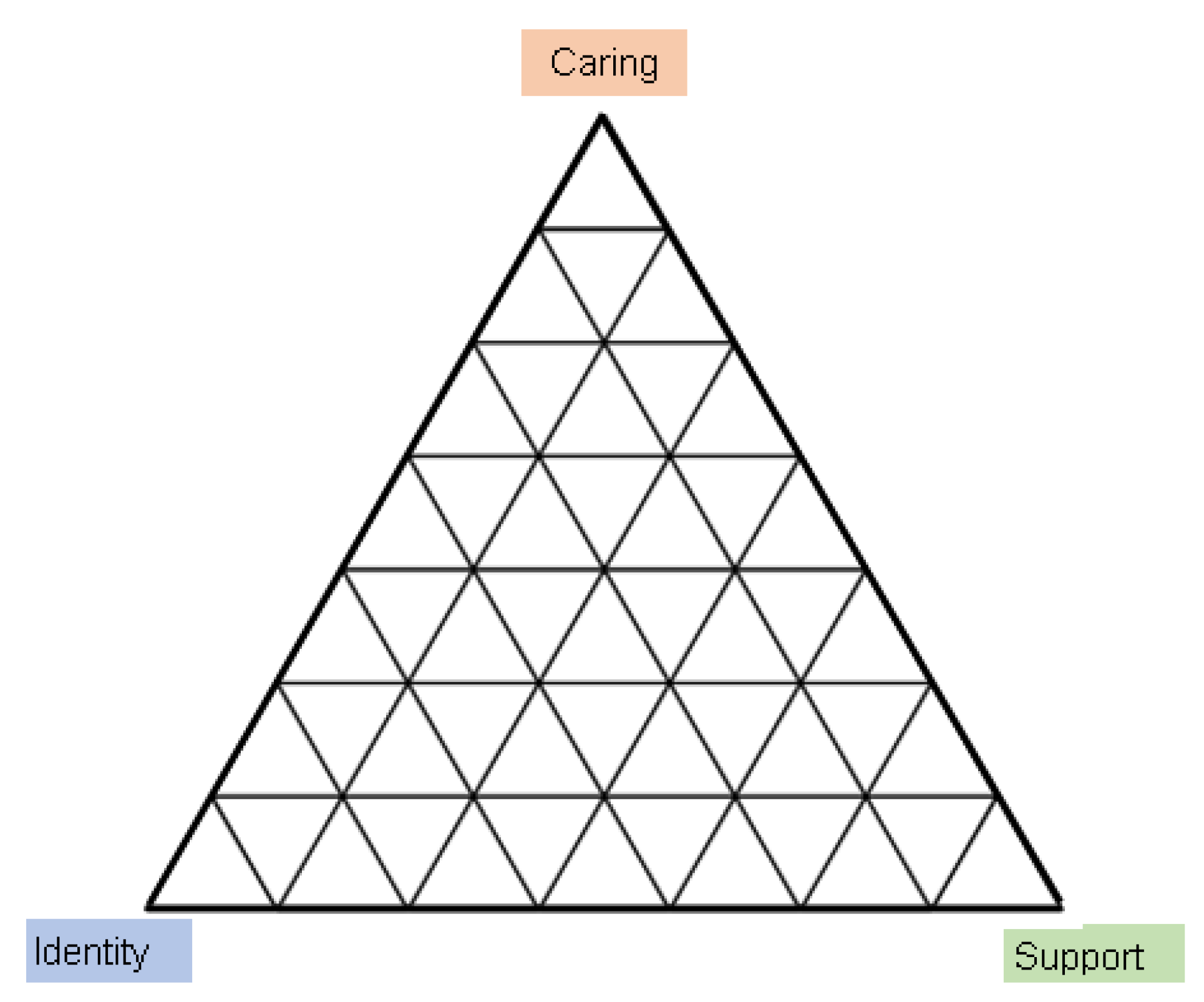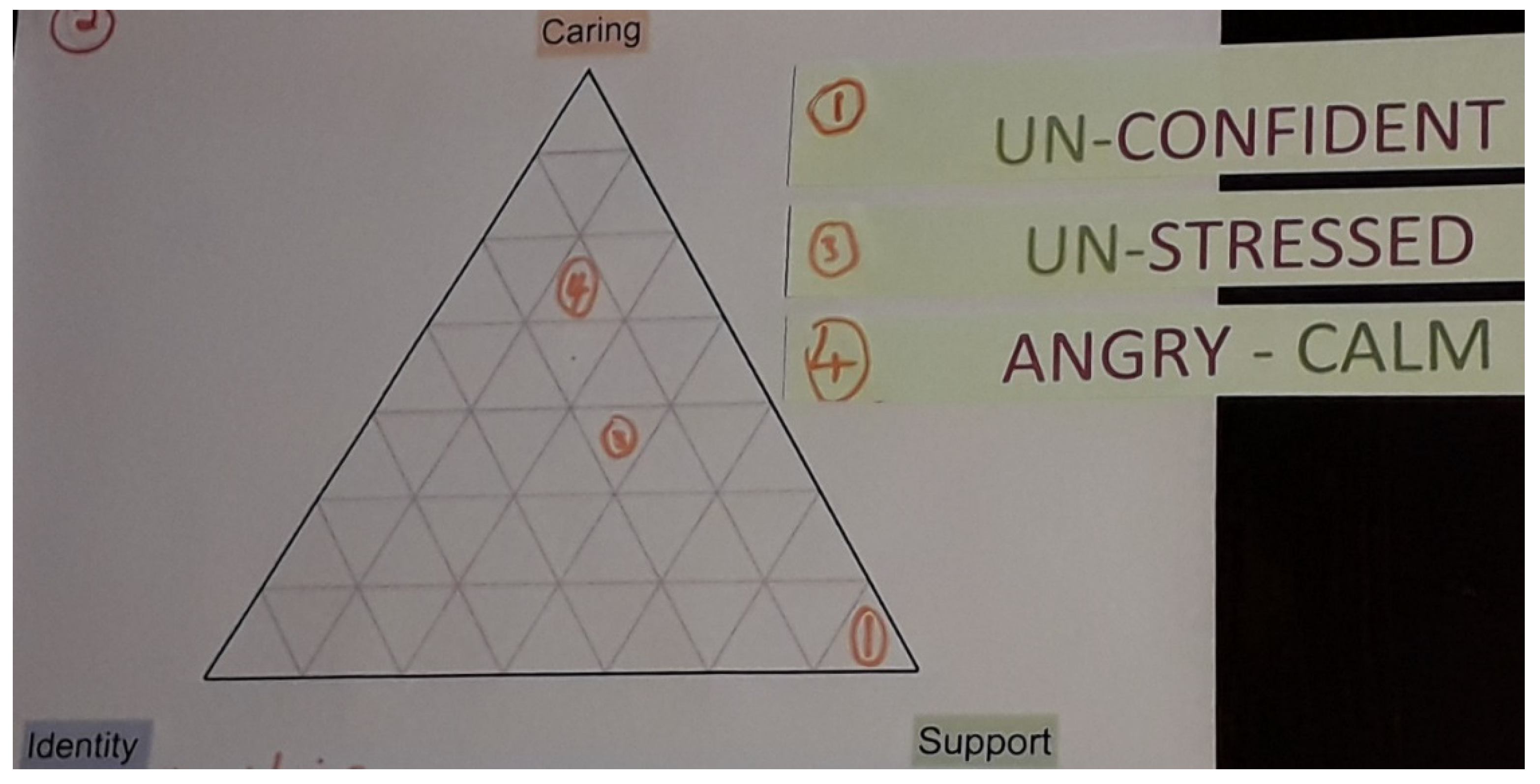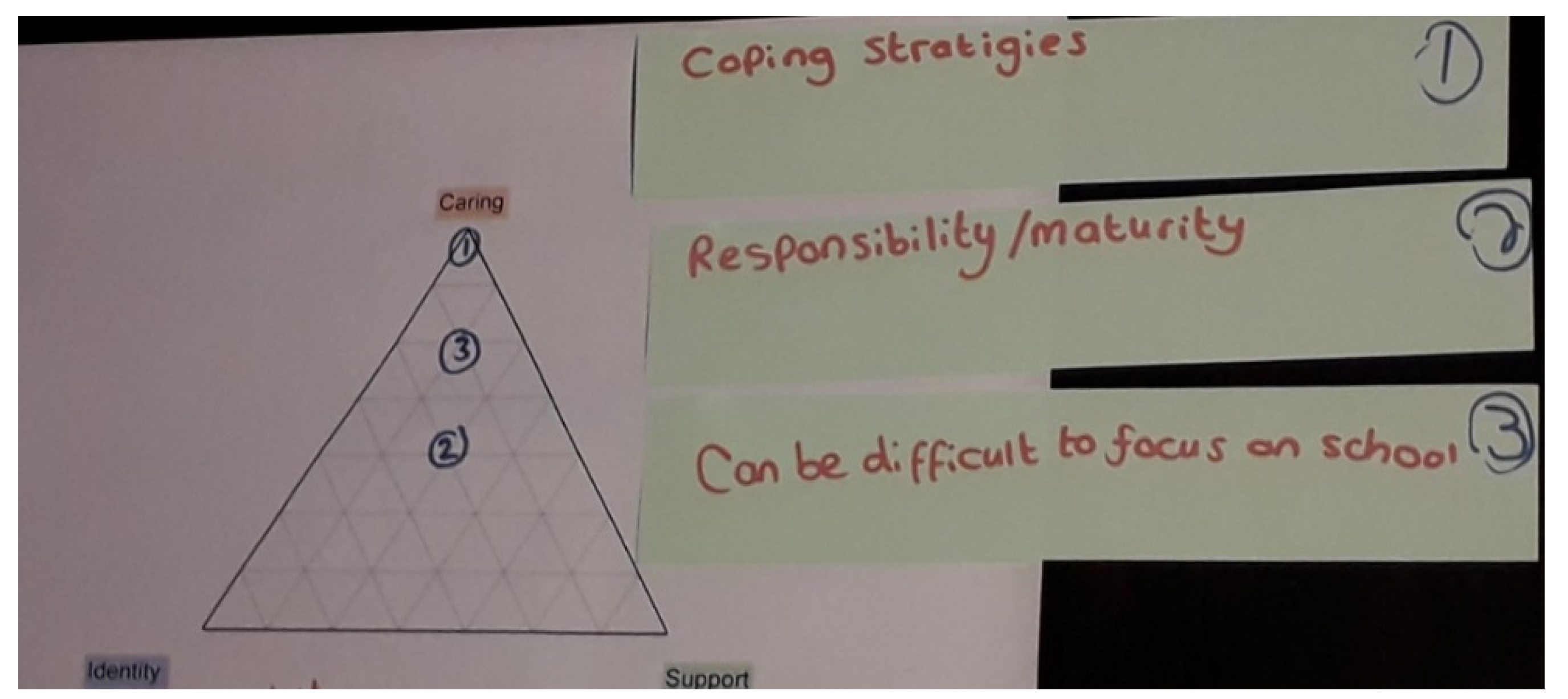Young Carer Perception of Control: Results of a Phenomenology with a Mixed Sample of Young Carers Accessing Support and Unknown to Services
Abstract
:1. Introduction
1.1. Trends in Young Carer Research
1.2. Young Carer Representation in Past Research
2. Materials and Methods
2.1. Recruitment
2.1.1. Participant Information
2.1.2. Participant Retention
2.2. Phenomenological Interviews
Analysis
3. Results
3.1. Perception of Control in the Lives of Young Carers
It’s that simple, if I’ve got to write an essay, I write an essay and I do my other stuff around it, I have my priorities and school comes first and then the other two [caring and social] kind of balance off each other… it makes it easier, because it’s like, I know if I’m going to have to do anything that evening, and if I’m not going to, it makes it easier to plan stuff.Angela (I3)
[During the pandemic] I still had to do like some of the stuff, like get him out of bed in the morning and stuff, and like help him down to the car, if I need to go out shopping or stuff. There’s [also] been… help feeding and stuff, like feeding him, because usually he’s at school so but yeah apart from that, those things have been the same.Harry (I3)
It makes me feel happy, because helping my brother makes me feel happy. And [not] lonely, I feel like I’ve got lots of people, lots of support, you know, helping me and stuff like that. Confident, I feel confident in my ability to care for my brother, and to not let him down I guess… And then helping me to feel mature, because it makes me feel independent.Harry (I1)
Positive Instability: Decreasing Responsibilities and Transition into the Carer Role
I could easily just say ‘I give up. You go and do everything yourself’. I could easily go and say that, and my mother probably would panic and she probably would have a go at me. Things would get a little difficult for a bit but she would get herself around it all.Richard (I1)
Normally we relax for like half an hour, and then I help her for an hour normally, half an hour, getting stuff before we start to cook tea, and then around half past four we start cooking tea and that’s about an hour, so about an hour and a half there, and then we eat tea, and then I normally help get her stuff ready, so that’s about another half an hour grabbing all her stuff and helping take it upstairs, and then normally I’m in her room for about half an hour, talking to her and just helping her around her room, closing her curtains,… I’d say about two and a half, three hours… It’s not much.Martin (I1)
It’s not good but I always like, I’m always annoyed. Like I value what I do but like I’m always annoyed and stuff, I have a really short temper. It’s like I used to but now, when my mum asks me to do stuff I’m always like ‘Argh’, and I know it’s not nice for my mum but I’m just, and when I wake up I’m a bit mean. But I, I don’t really know what I can do to stop that.Martin (I1)
3.2. Threats to Control of the Caring Role
3.2.1. Changing Care-Receiver Needs and Instability in the Caring Role
I help my mum when she gets ready in the mornings… so I’d say that’s about hour and a half getting her ready and getting myself ready. As soon as I come home, we usually do a daily shop because it’s not too much for my mum. So I’m there helping her with her shopping, and then I’m helping her then with the dishes. So about two hours then after school. Then we eat, so I help her with the food. It’s a good six/seven hours a day I would say.Thea (I1)
When I come back into school, I got my head down like, focused as much as I could, because I didn’t want to let myself down, didn’t want to let myself fade away, it’s my last year, I’ve literally got about nine months left, there’s no point me messing it up now… It was hard at first, but I got back into the routine of, I’m doing well in school.Thea (I2)
Anger, definitely comes in, but not just my young carer role… I have tried to calm down a lot more, yeah so my anger isn’t as bad as it used to be, I don’t break things as much no more… I am proud of myself for being where I am now, because I was at a very low point when I finished school last year, I was extremely suicidal, tried to commit suicide three times last year, because of everything that happened.Thea (I2)
3.2.2. Excessive and Night-Time Caring
Social time’s done in school. Sister’s like after school and homework is trying to fit in anywhere possible like I’ll try and do homework before helping her but you never know when she needs help so it’s sort of keeping an eye on her whilst trying to do my work… sometimes it’s like I’ll forget about doing the homework because something else will crop up like she needs something and so it’ll be like the night before that I’m trying to rush trying to do it, so it is quite difficult.Patrick (I1)
I’ll have lots of homework to do and then my mum will need my help. And it’s like deciding which one’s more important… [If undertake caring task] I feel like I’ve helped my mum but then I’ve got to catch up on my own work… [If do homework] It makes me feel like I’ve done all my homework so I’m gonna be up to date, but then like, my mum might still be struggling, and like sometimes she’s like shaking as well so she can’t do it, and that’s why she asks me to do it… I feel like quite bad in the sense that I didn’t help her at the start.Sophie (I3)
3.2.3. Medical Responsibilities
When you test [her blood] it will start to show an improvement and she’ll start to feel better. If it doesn’t then you can get really, really impatient and angry about it… she had a hypo, I think it was last month or something, and it went down to like two or something and my mum didn’t wanna like, she didn’t wanna eat, so I was like force feeding her to eat, and then she was like, she just didn’t want to do anything, and then she was getting really hot and sweaty, and she had two or three cups of orange juice and two Twirls and it still took her a good 20 min for it to get back to a reasonable level that she could then go back to sleep.Sophie (I2)
4. Discussion
Limitations and Opportunities for Further Work
5. Conclusions
Funding
Institutional Review Board Statement
Informed Consent Statement
Data Availability Statement
Acknowledgments
Conflicts of Interest
References
- Joseph, S.; Sempik, J.; Leu, A.; Becker, S. Young Carers Research, Practice and Policy: An Overview and Critical Perspective on Possible Future Directions. Adolesc. Res. Rev. 2020, 5, 77–89. [Google Scholar] [CrossRef] [Green Version]
- Aldridge, J.; Becker, S. Children Who Care—Inside the World of Young Careers; Department of Social Sciences, Loughborough University: Leicestershire, UK, 1993. [Google Scholar]
- Aldridge, J.; Becker, S. Punishing children for caring: The hidden cost of young carers. Child. Soc. 1993, 7, 376–387. [Google Scholar] [CrossRef]
- Aldridge, J. Where are we now? Twenty-five years of research, policy and practice on young carers. Crit. Soc. Policy 2018, 38, 155–165. [Google Scholar] [CrossRef] [Green Version]
- Department of Health. Carers (Recognition and Services) Act Practice Guide; Department of Health and Social Care: London, UK, 1995.
- Kavanaugh, M.S.; Henning, F.; Mochan, A. Young carers and ALS/MND: Exploratory data from families in South Africa. Vulnerable Child. Youth Stud. 2021, 16, 123–133. [Google Scholar] [CrossRef]
- Skovdal, M.; Ogutu, V.O. “I washed and fed my mother before going to school”: Understanding the psychosocial well-being of children providing chronic care for adults affected by HIV/AIDS in Western Kenya. Glob. Health 2009, 5, 8–10. [Google Scholar] [CrossRef] [Green Version]
- Hilário, A.P. Sibling caring roles and responsibilities when a child suffers from a chronic illness. Sociol. Compass 2022, 16, 1–11. [Google Scholar] [CrossRef]
- Nagl-Cupal, M.; Prajo, N. It is something special: How children and their parents experience a camp for young people who care for a parent with a severe physical illness. Child. Youth Serv. Rev. 2019, 107, 104560. [Google Scholar] [CrossRef]
- Kavanaugh, M.S.; Cho, Y.; Fee, D.; Barkhaus, P.E. Skill, confidence and support: Conceptual elements of a child/youth caregiver training program in amyotrophic lateral sclerosis—The YCare protocol. Neurodegener. Dis. Manag. 2020, 10, 231–241. [Google Scholar] [CrossRef]
- Cassidy, T.; Giles, M.; McLaughlin, M. Benefit finding and resilience in child caregivers. Br. J. Health Psychol. 2013, 19, 606–618. [Google Scholar] [CrossRef]
- McGibbon, M.; Spratt, T.; Davidson, G. Young carers in Northern Ireland: Perceptions of and responses to illness and disability within the family. Br. J. Soc. Work 2019, 49, 1162–1179. [Google Scholar] [CrossRef]
- Gough, G.; Gulliford, A. Resilience amongst young carers: Investigating protective factors and benefit-finding as perceived by young carers. Educ. Psychol. Pract. 2020, 36, 149–169. [Google Scholar] [CrossRef]
- Olsen, R.; Clarke, H. Parenting and Disability: Disabled parents’ Experiences of Raising Children; The Policy Press: Bristol, UK, 2003. [Google Scholar]
- Lewis, F.M.; Becker, S.; Parkhouse, T.; Joseph, S.; Hlebec, V.; Mrzel, M.; Brolin, R.; Casu, G.; Boccaletti, L.; Santini, S.; et al. The first cross-national study of adolescent young carers aged 15–17 in six European countries. Int. J. Care Caring 2022, 1–28. [Google Scholar] [CrossRef]
- Robison, O.M.E.F.; Inglis, G.; Egan, J. The health, well-being and future opportunities of young carers: A population approach. Public Health 2020, 185, 139–143. [Google Scholar] [CrossRef] [PubMed]
- Sharpe, R.A.; Russell, N.; Andrews, R.; Curry, W.; Williams, A.J. A school-based cross-sectional study to understand the public health measures needed to improve the emotional and mental wellbeing of young carers aged 12 to 14 years. In Families, Relationships and Societies; Policy Press: Bristol, UK, 2021; pp. 1–19. [Google Scholar]
- Chalmers, H. Young Carers’ Self-Compassion and Subjective Well-Being Relative to Non-Caregiving Youth. J. Artic. Support Null Hypothesis 2022, 18, 67–75. [Google Scholar]
- Leu, A.; Becker, S. A cross-national and comparative classification of in-country awareness and policy responses to ‘young carers’. J. Youth Stud. 2017, 20, 750–762. [Google Scholar] [CrossRef] [Green Version]
- Leu, A.; Berger, F.M.P.; Heino, M.; Nap, H.H.; Untas, A.; Boccaletti, L.; Lewis, F.; Phelps, D.; Becker, S. The 2021 cross-national and comparative classification of in-country awareness and policy responses to ‘young carers’. J. Youth Stud. 2022, 1–18. [Google Scholar] [CrossRef]
- Boyle, G. The Moral Resilience of Young People Who Care. Ethics Soc. Welf. 2020, 14, 266–281. [Google Scholar] [CrossRef]
- Landi, G.; Boccolini, G.; Giovagnoli, S.; Pakenham, K.I.; Grandi, S.; Tossani, E. Validation of the Italian Young Carer of Parents Inventory-Revised (YCOPI-R). Disabil. Rehabil. 2022, 44, 795–806. [Google Scholar] [CrossRef]
- Wepf, H.; Leu, A. Well-Being and Perceived Stress of Adolescent Young Carers: A Cross-Sectional Comparative Study. J. Child Fam. Stud. 2021, 31, 934–948. [Google Scholar] [CrossRef]
- Sahoo, R.; Suar, D. Do young carers deserve justice? Young caring in the context of illness. Psychol. Dev. Soc. 2009, 21, 133–150. [Google Scholar] [CrossRef]
- Rose, H.D.; Cohen, K. The experiences of young carers: A meta-synthesis of qualitative findings. J. Youth Stud. 2010, 13, 473–487. [Google Scholar] [CrossRef]
- Janes, E.; Forrester, D.; Reed, H.; Melendez-Torres, G.J. Young carers, mental health and psychosocial wellbeing: A realist synthesis. Child Care Health Dev. 2021, 48, 190–202. [Google Scholar] [CrossRef] [PubMed]
- Morris, J.; Keith, L. Easy targets: A disability rights debate. Crit. Soc. Policy 1995, 44–45, 36–57. [Google Scholar]
- Newman, T. Children of Disabled Parents: New Thinking about Families Affected by Disability and Illness; Russell House: Lyme Regis, UK, 2003. [Google Scholar]
- Aldridge, J.; Becker, S. Disability rights and the denial of young carers: The dangers of zero-sum arguments. Crit. Soc. Policy 1996, 16, 55–76. [Google Scholar] [CrossRef]
- Welsh Government. The Carers Strategy for Wales; Carers Strategy for Wales: Wales, UK, 2013.
- UK Government. Care Act; UK Government: London, UK, 2014.
- Becker, S.; Aldridge, J.; Dearden, C. Young Carers and Their Families; Blackwell Science: Oxford, UK, 1998. [Google Scholar]
- Leu, A.; Becker, S. Young carers. In Oxford Bibliographies in Childhood Studies; Oxford University Press: New York, NY, USA, 2019. [Google Scholar]
- Janes, E. Caring Lives: What Do Young People Who Care for Family Members Need to Thrive? An Empirical Investigation. Ph.D. Thesis, Cardiff University, Cardiff, UK, 2022. [Google Scholar]
- Lloyd, K. Happiness and Well-Being of Young Carers: Extent, Nature and Correlates of Caring Among 10 and 11 Year Old School Children. J. Happiness Stud. 2013, 14, 67–80. [Google Scholar] [CrossRef]
- Hewitt, G.; Anthony, R.; Moore, G.; Melendez-Torres, G.J.; Murphy, S. Student Health and Wellbeing in Wales: Report of the 2017/18 Health Behaviour in School-Aged Children Survey and School Health Research Network Student Health and Wellbeing Survey. 2019. Available online: https://www.shrn.org.uk/national-data/ (accessed on 21 February 2020).
- Gadamer, H.-G. Truth and Method, 2nd ed.; Continuum: London, UK, 2004. [Google Scholar]
- Bartolini, S. On time and comparative research. J. Theor. Politics 1993, 5, 131–167. [Google Scholar] [CrossRef]
- van Manen, M. Phenomenology of Practice: Meaning-Giving Methods in Phenomenological Research and Writing; Routledge: London, UK, 2016. [Google Scholar]
- Andersen, L.B. Children’s caregiving of HIV-infected parents accessing treatment in western Kenya: Challenges and coping strategies. Afr. J. AIDS Res. 2012, 11, 203–213. [Google Scholar] [CrossRef]
- Martin, R. Children’s perspectives: Roles, responsibilities and burdens in home-based care in Zimbabwe. J. Soc. Dev. Afr. 2006, 21, 106–129. [Google Scholar]
- Lane, T.; Cluver, L.; Operario, D. Young carers in South Africa: Tasks undertaken by children in households affected by HIV infection and other illness. Vulnerable Child. Youth Stud. 2015, 10, 55–66. [Google Scholar] [CrossRef]
- Kavanaugh, M.S. Children and Adolescents Providing Care to a Parent with Huntington’s Disease: Disease Symptoms, Caregiving Tasks and Young Carer Well-Being. Child Youth Care Forum 2014, 43, 675–690. [Google Scholar] [CrossRef]




| Demographics | Care Receiver Details | Caring Details (at Interview 1) | ||||||||
|---|---|---|---|---|---|---|---|---|---|---|
| No | Setting | Interviews Completed | Name | Sex | Age | Care Receiver | Reason for Need | Duration as Young Carer | Level of Care | Key Responsibilities |
| 1 | School | 3 | Sophie | F | 13 | Mother | Diabetes, hearing impairment | 9 years | Main | Medical care (force feeding, injections to stabilize blood sugar levels); companionship; translation |
| 2 | School | 3 | Angela | F | 13 | Mother | MS | 2 years | Main | Companionship; domestic responsibilities |
| 3 | School | 3 | Kirsty | F | 14 | Mother * | Spina bifida, hydrocephalus, epilepsy | 5 years | Joint | Domestic responsibilities; companionship |
| 4 | School | 3 | Martin | M | 13 | Mother | Aplastic anaemia | 9 months | Main | Physical support; domestic responsibilities |
| 5 | Project | 1 | Lyra ** | F | 13 | Mother | Bipolar disorder | 4 years | Joint | Domestic responsibilities |
| 6 | Project | 1 | Lucy ** | F | 11 | Mother | Bipolar disorder | 2 years | Joint | Domestic responsibilities; nursing |
| 7 | Project | 3 | Harry *** | M | 16 | Brother | Autism | 11 years | Joint | Getting up in the morning; physical support; taking to school; caring after school |
| 8 | School | 3 | Patrick *** | M | 14 | Sister | Cerebral palsy; learning difficulties | 9 years | Joint | Physical support; monitoring |
| Grandfather * | Old age, dizziness, confusion | Domestic responsibilities | ||||||||
| 9 | Project | 2 | Richard | M | 16 | Mother | Former substance misuse; mental health | 11 years | Main | Emotional support; domestic responsibilities |
| 10 | Project | 2 | Thea ** | F | 16 | Mother | Bipolar disorder | 4 years | Main | Companionship; nursing; domestic responsibilities |
Publisher’s Note: MDPI stays neutral with regard to jurisdictional claims in published maps and institutional affiliations. |
© 2022 by the author. Licensee MDPI, Basel, Switzerland. This article is an open access article distributed under the terms and conditions of the Creative Commons Attribution (CC BY) license (https://creativecommons.org/licenses/by/4.0/).
Share and Cite
Janes, E. Young Carer Perception of Control: Results of a Phenomenology with a Mixed Sample of Young Carers Accessing Support and Unknown to Services. Int. J. Environ. Res. Public Health 2022, 19, 6248. https://doi.org/10.3390/ijerph19106248
Janes E. Young Carer Perception of Control: Results of a Phenomenology with a Mixed Sample of Young Carers Accessing Support and Unknown to Services. International Journal of Environmental Research and Public Health. 2022; 19(10):6248. https://doi.org/10.3390/ijerph19106248
Chicago/Turabian StyleJanes, Ed. 2022. "Young Carer Perception of Control: Results of a Phenomenology with a Mixed Sample of Young Carers Accessing Support and Unknown to Services" International Journal of Environmental Research and Public Health 19, no. 10: 6248. https://doi.org/10.3390/ijerph19106248
APA StyleJanes, E. (2022). Young Carer Perception of Control: Results of a Phenomenology with a Mixed Sample of Young Carers Accessing Support and Unknown to Services. International Journal of Environmental Research and Public Health, 19(10), 6248. https://doi.org/10.3390/ijerph19106248






